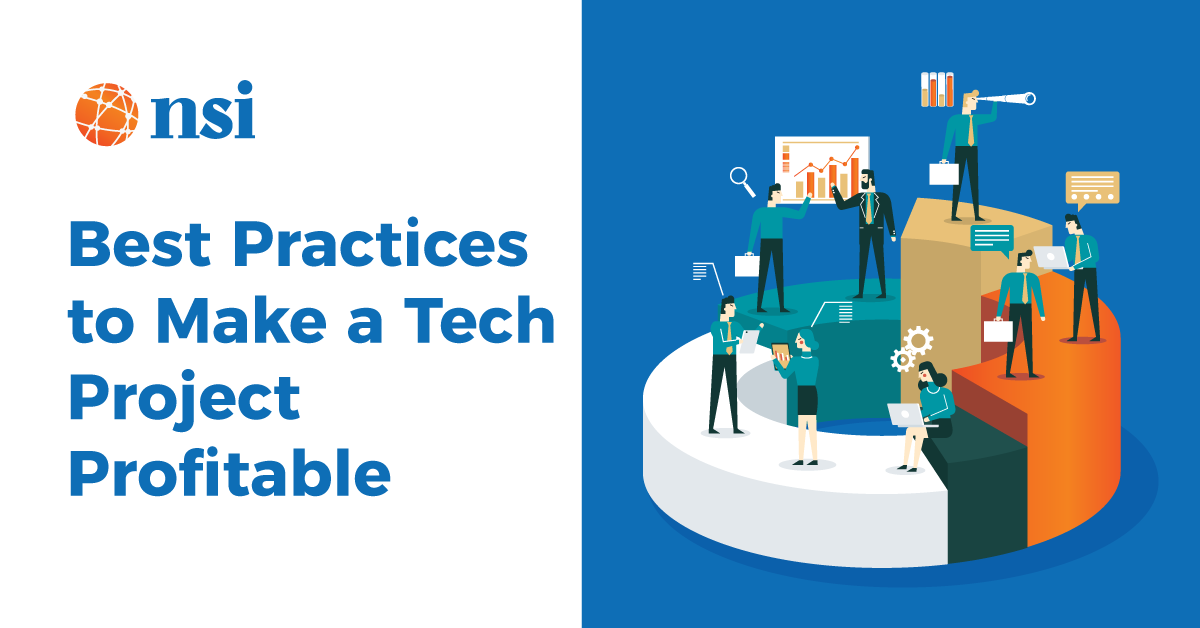
After seeing other companies implement technology projects that have revolutionized business, leaders may realize that incorporating tech into operations has great potential to become profitable. One study that reviewed years of data from more than 400 global companies found that IT investments that enable sales are more likely to increase business profitability than those that help reduce business costs.
You may be ready to invest in tech-driven sales enablement for your Connecticut SMB. But, how can you make sure projects implemented actually increase profits? Take a look at our recommended five best practices that help make technology projects profitable.
1. Defining Your IT Project’s Scope & Timeline
A project that goes smoothly from start to finish may be ideal, but this is definitely not the reality. Making sure to define your IT project’s scope is foundational in planning for the project’s success and making it profitable. Project management professionals recommend that, when writing a scope document, you encourage your leaders to set defined lines of responsibility, so that it’s clear to each collaborator what area they will contribute to while developing the project.
Ensuring your team sets clear objectives prior to project implementation will help curb improvisation and prioritize what’s truly important. Having a scope document in hand will help you guide your team to navigate within the bounds of the project’s big picture. By ensuring all staff adhere to the document, you can prevent last-minute decisions that could become unnecessary expenses.
However, scope is only one side of the coin. Another way to avoid costly mistakes and increase the potential for profitability is to make sure the project timeline and scheduling are realistic. Having a degree of predictability will minimize the risk of setting unrealistic goals. To increase success, ask your team to track the time spent on specific tasks and to allow for slack in the timeline to implement process improvements when necessary.
Implementing this practice into each project’s workflow will help predict performance and timing on future projects, as well as afford your project managers the insight and time they need into taking corrective action.
2. Establishing & Monitoring a Budget
Clearly defined scope and timelines will only truly work if your key management has visibility on all fronts, especially project financials. This implies establishing a budget to enable technology project profitability. In our experience, if your financial and project management leaders gain a top-down view of all resources allocated to the project, they will help your business make more strategic decisions. We recommend leaders like you empower management with the tools necessary to assess how the project will become an investment that will increase profits for your business.
Taking into account pre-implementation and post-implementation when evaluating projects is one practice that can strengthen budget planning and therefore maximize your project profits. For example, if you are implementing an enterprise product to use internally, reviewing the cost of maintaining and updating the system over the coming years will ensure you have a complete picture when creating your budget. You might consider the possibility of hiring externally for the maintenance of the tool, since this could allow your internal team to focus on other key areas and could create savings in the long run.
Once you've created and established the project budget, monitoring it is a fundamental project management technique that contributes to overall project profitability. We recommend you make sure you are engaging your financial team along with the project managers to track and control expenditures.
3. Engaging All Stakeholders
Engaging financial and other management leaders is important, but in our experience, engaging all stakeholders in the project contributes tremendously to its success. The questions below may help you take into account the multiple perspectives of your project stakeholders to ensure digital transformation will improve operations and bring more profits to the business.
- Questions for your project’s user base: What are your expectations of this project? What should the new technology accomplish for your team? Will this project improve your day-to-day performance? How so? What are some of the intangible benefits of this project? How can we represent these goals correctly in our scope document?
- Things to ask sales & marketing: Once this project has been implemented, how can using it help you land more leads? Convert leads into customers? How can the project help you sell more services to existing customers? Is there any functionality we are overlooking in the project?
- Make sure to involve senior leadership: Will this project benefit more than one business unit? How can we best coordinate our teams to maximize impact? How can we leverage lessons learned from other projects? How canwe cut back on costs?
- Here’s what to ask from your IT team: What does each phase look like for this project? What assets and capabilities will we need before, during, and after implementation? Do we have the expertise in-house to accomplish the project goals? What extra resources or added expertise do we need for this project to be the most successful?
- Recapping what to discuss with the finance team: Have we considered what this project will cost in each phase? Have you discussed with other teams what the benefits of implementing it are? Have you determined that those benefits outweigh the project costs? Could we reduce overall costs by partnering with an external consultant?
- What to ask when evaluating potential external partners: What specific expertise do you bring to the table that will make this project successful? How can we maximize collaboration between your team and our internal resources?
4. Tracking the Right Metrics
One of the most important steps to improving project profitability is to determine the success criteria that matter most to your company’s profitable growth. As you involve all interested parties during each project phase, make sure to ask each area what success will look like from their perspective. This will help ensure you are tracking the right metrics.
In addition, we recommend you keep the following area-specific metrics in mind for each project.
A) Compliance metrics
Ask your IT team: are we implementing this project because we are legally required to do so? If so, what are some of the project milestones and key performance indicators (KPIs) that will let us know we are on the right track to compliance?
B) Financial metrics
Some financial KPIs you may want to track are return on investment (ROI), break even analysis (BEA), net present value (NPV), and internal rate of return (IRR). Ask your team if this project will produce benefits that can be measured monetarily. For example, a project may produce a savings in labor hours, reduce cost of operations, or otherwise give the implementing company a financial advantage.
While calculating the ROI of a technology project may seem difficult, it isn’t impossible to do. If you are able to achieve this, in your review, you may see tangible benefits of implementing the project. For example, if a technology project enables service expansion into other areas or offering new services to existing clients, these are tangible benefits that increase a project's ROI and therefore it's profitability.
In addition, while tech projects that cut business costs aren’t the most likely to increase company profits, being aware of where your team can save on project costs will create tangible benefits that can contribute to its profitability. We recommend you track these savings. Your finance team will be able to assign a figure to each one.
C) Mission-driven metrics
How is this project aligned with company vision and goals? Make sure to engage your leadership team to draft KPIs related to your company's overall business goals. Aligning IT with business like this can promote increased collaboration, which tends to increase productivity and therefore the company profits.
D) Metrics related to project management
Using time logs can contribute to tracking the project overrun metric, which represents a percentage of the resulting project cost compared to its planned cost. Along with logging time spent on a particular task or set of tasks, calculating resulting operational costs and comparing them with estimates helps managers increase predictability, improve their estimation and resource allocation techniques, and make additional costs more manageable. Essentially, project overrun shows how reliable your planning is and what unexpected costs tend to incur in your project, so you can learn from the experience.
If you've allowed for some flexibility in your project's timeline, as recommended in an earlier section, it's possible for your IT and project management experts to use the information from established metrics to steer a project in the right direction and maximize profitability. Both practices will contribute to continuous improvement in your business.
5. Partnering with the Right IT Project Consultants
Could your company generate savings by improving how you use internal IT resources? When resources are scarce, internal teams often find themselves juggling multiple projects at once. If teams are stretched thin, it may be much harder to identify when there is a gap in skills or when the unit's goals are not aligned to business goals. While this is usually the status quo in an SMB, genuine digital transformation — like the kind that will revolutionize the business — rarely occurs under these circumstances.
In October, our state was featured in the IBM Center for The Business of Government’s Adopting Agile in State and Local Governments report. The report describes a 20-year foundation in Connecticut’s use of lean project management and Agile, focusing on incremental changes and continuous improvement.
The report highlights the Kid’s Information Network Database project (CT-KIND) project, developed in 2018, which overhauled a two-decade old legacy system. This project was the first to use the Agile methodology, after the Office of Planning and Management issued OPM-CT 2017, a policy that provided explicit guidelines to promote better control over technology project timelines, costs, and quality. One guideline explicitly included using Agile project management.
What did this mean for the CT-KIND project? To improve project timelines, costs, and quality, project managers developed the project through multiple vendors that took on smaller modular contracts using an iterative delivery process.
What can Connecticut SMB leaders learn from this? You might consider hiring transformation experts to focus on one area of the project while your internal team focuses on another area. The value of working both areas in parallel could potentially maximize profits by helping you implement your project faster. This value would be greater than the cost of hiring your technology partner.
Partnering with the right managed services provider (MSP) can become key to ensuring your IT project contributes to overall company goals. An experienced MSP will understand that collaboration with your internal stakeholders, especially the finance unit, will be the base of accomplishing the best results. They will also have worked with dozens of companies in your industry and have developed an understanding of what tends to work to ensure a project's goals are compatible with your business goals.
The Right Management, Metrics & Insight to Make Technology Profitable
When it comes to profitable technology projects, Connecticut's SMB leaders will need to engage all interested parties to determine project scope, budget, and especially timeline. Encouraging your key leadership to monitor progress using predefined objectives and KPIs will empower them to quickly change course in case a certain task or series of tasks is taking up too many resources, time, or budget.
As your company's strategic head, you will need to assess the allocation of resources and determine whether partnering with an expert IT consultant may be the way to ensure project profitability.
Please contact us if you're ready to speak with an experienced MSP in Connecticut.








